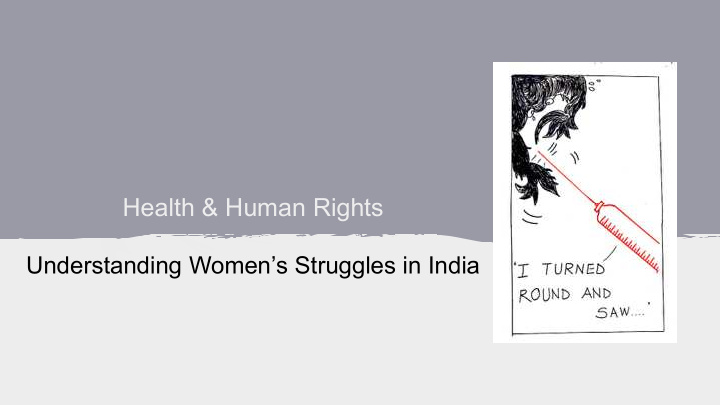



Health & Human Rights Understanding Women’s Struggles in India
Group Questions ● What does it mean to be healthy? ● What kinds of “health” can we have? ● What are ways that women can access health? ● What are barriers to women’s health?
Examples of Feminist Posters in India Title: “If we get love and nurturing, our identities Title: “80% of the women in our country are malnourished; will develop equally” Price rises increase the percentage” Publisher: Vadodara: Sahiyar Publisher: Vadodara: Sahiyar
Women’s Health in India Maintaining reproductive health, mental health and the treatment of sexually-transmitted illness is often a challenge for many Indian women. Numerous pregnancies and closely spaced births are common among many Indian women, and they erode a mother’s nutritional status, negatively affecting pregnancy outcomes (e.g. premature births, low birth-weight babies) and also increasing a mother's health risks.
Terms and Concepts Contraception Sexually Transmitted Disease HIV/AIDS Sterilization Infant Mortality Rates
Statistical Overview ● 92% of women in India suffer from gynecological-related health complications. ● 38% of all HIV positive people in India are women, yet only 25% of beds in care centers are occupied by them. ● 88% of pregnant women have anemia due to nutritional discrimination. ● 75% of the women recommended to use contraception are then sterilized.
Assignment ● Using the South Asian Feminist Activism Archive, research strategies used by grassroots Indian organizations to raise awareness around women’s health disparities. ● Identify three important health issues concerning grassroots activists, and write a two page summary describing what specific methods they used to educate the public about health barriers (e.g. colorful signs, pamphlets, street plays). ● Conduct your own research to find out if these methods were effective in creating positive change for women’s health access in their communities.
For more information please visit the South Asian Feminist Activism Archive at: http://uwdc.library.wisc.edu/collections/GenderStudies Thank you!
Recommend
More recommend